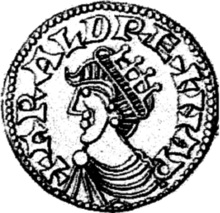
Back Harold III Norrena Cyning ANG هارلد الثالث ملك النرويج Arabic هارلد التالت ملك النرويج ARZ هارالد هاردرادا AZB Харалд Хардрада Bulgarian Harald III Norge Breton Harald III, kralj Norveške BS Harald III de Noruega Catalan Harald III. Norský Czech Harald Hardrada Welsh
| Harald Hardrada | |||||
|---|---|---|---|---|---|
 Coin of Harald as the sole Norwegian king, "ARALD[us] REX NAR[vegiae]". Imitation of a type of Edward the Confessor.[1] | |||||
| King of Norway | |||||
| Reign | 1046 – 25 September 1066 | ||||
| Predecessor | Magnus I | ||||
| Successor | Magnus II | ||||
| Co-ruler | Magnus I (until 1047) | ||||
| Born | c. 1015 Ringerike, Norway | ||||
| Died | 25 September 1066 (aged 50–51) Stamford Bridge, Yorkshire, England | ||||
| Burial | Trondheim; Mary Church until 12th century, Helgeseter Priory until 17th century (demolished) | ||||
| Spouses | |||||
| Issue | |||||
| |||||
| House | Hardrada | ||||
| Father | Sigurd Syr | ||||
| Mother | Åsta Gudbrandsdatter | ||||
| Religion | Christianity | ||||
Harald Sigurdsson (Old Norse: Haraldr Sigurðarson; c. 1015 – 25 September 1066), also known as Harald III of Norway and given the epithet Hardrada in the sagas,[2] was King of Norway from 1046 to 1066. He unsuccessfully claimed the Danish throne until 1064 and English throne in 1066. Before becoming king, Harald spent 15 years in exile as a mercenary and military commander in Kievan Rus' and chief of the Varangian Guard in the Byzantine Empire. In his chronicle, Adam of Bremen called him the "Thunderbolt of the North".[3]
In 1030, the fifteen-year old Harald fought in the Battle of Stiklestad with his half-brother Olaf Haraldsson. Olaf sought to reclaim the Norwegian throne, which he had lost to Danish king Cnut two years prior. Olaf and Harald were defeated by forces loyal to Cnut, and Harald was forced into exile to Kievan Rus'. Thereafter, he was in the army of Grand Prince Yaroslav the Wise, becoming captain, until he moved on to Constantinople with his companions around 1034. In Constantinople, he rose quickly to become the commander of the Byzantine Varangian Guard, seeing action on the Mediterranean Sea, in Asia Minor, Sicily, possibly in the Holy Land, Bulgaria and in Constantinople itself, where he became involved in the imperial dynastic disputes. Harald amassed wealth whilst in the Byzantine Empire, which he shipped to Yaroslav in Kievan Rus' for safekeeping. In 1042, he left the Byzantine Empire, returning to Kievan Rus' to prepare to reclaim the Norwegian throne. In his absence the Norwegian throne had been restored from the Danes to Olaf's illegitimate son Magnus the Good.
In 1046, Harald joined forces with Magnus's rival in Denmark, the pretender Sweyn II of Denmark, raiding the Danish coast. Magnus, unwilling to fight his uncle, agreed to share the kingship with Harald, since Harald in turn would share his wealth with him. The co-rule ended abruptly the next year as Magnus died: Harald became the sole ruler of Norway. Domestically, Harald crushed opposition, and outlined the unification of Norway. Harald's reign was one of relative peace and stability, and he instituted a coin economy and foreign trade. Seeking to restore Cnut's "North Sea Empire", Harald claimed the Danish throne, and spent nearly every year until 1064 raiding the Danish coast and fighting his former ally, Sweyn. Although the campaigns were successful, he was never able to conquer Denmark.
Not long after Harald had renounced his claim to Denmark, the former Earl of Northumbria, Tostig Godwinson, brother of English king Harold Godwinson, pledged his allegiance to Harald, inviting him to claim the English throne. Harald assented, invading northern England with 10,000 troops and 300 longships in September 1066, defeating the English regional forces of Northumbria and Mercia in the Battle of Fulford near York on 20 September. Harald was defeated and killed in a surprise attack by Harold Godwinson's forces in the Battle of Stamford Bridge on 25 September, which wiped out his army. Historians often consider Harald's death the end of the Viking Age.
- ^ Schive (1865) p. 26
- ^ "Det store norske leksikon" (The Great Norwegian Encyclopedia)
- ^ Hollway, Don (2021). The Last Viking: The True Story of King Harald Hardrada. Osprey Publishing. p. 23. ISBN 978-1-4728-4650-1.